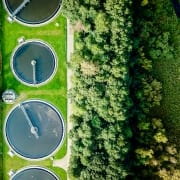Following a keynote speech at the Enterprise Ireland and Wet Networks (an Arup and WRC initiative) Water Innovation Seminar in February, Trevor Bishop spoke to Enterprise Ireland to discuss key issues explored at the event. Bishop is Organisational Development Director with Water Resources South East in the UK.
Water companies in England and Wales face demanding requirements for Asset Management Planning Period 7 (AMP7), with the next five-year plan for the sector covering the period 2020-2025. The economic water regulator Ofwat has said that issues to be addressed include population growth, climate change and water scarcity. Companies must also deliver on a need for fairer pricing, water supply resilience, and environmental protection.
Bishop stresses that requirements present a major opportunity for innovators to connect with water companies. One of the biggest problems faced is leakage, with many companies committing to reducing leaks by around 15% during AMP7. Bishop said, “It’s a very significant challenge. The boards [of water companies] have shown high levels of ambition following challenges set down by regulators. However, these ambitions will require companies to go beyond what they know they can do and will rely on real innovation to deliver.”
“It isn’t always easy for an SME to work directly with a big water company. We need to make sure we can find the right partnerships, so that innovation can be used where it’s appropriate and we can share and learn better between us”.
Bishop outlines what lies beneath
Much of a water company’s asset base is below ground, the network of pipes. A significant challenge is that knowledge about these assets is often limited: “It’s very difficult to understand their condition. We all too often tend to only know that there is a problem when something starts to go wrong,” Bishop explained.
One area in which innovators can assist water companies include the need for technology to monitor performance, condition, bursts and damage: “We’re starting to see some breakthrough technologies that could actually be quite disruptive, with regard to these aspects, particularly the shift from performance to condition monitoring.”
Bishop mentioned the potential to adapt ideas from other sectors. As we know, modern cars now use an electric current that flows through the windscreen, allowing it to detect water drops, so that wipers activate when it starts to rain. We are starting to see people thinking about similar application in the pipe network to alert companies to condition and leaks.
As its name suggests, Water Resources South East is an alliance between six water companies from the south east of England. It faces some major challenges arising with AMP7 and will need to increase capacity by roughly one third through to 2050 while needing to reduce its traditional reliance on mainly rivers and groundwater.
Bishop commented, “Most catchments are effectively fully licensed in terms of abstraction, so we need to look for innovations, new and different ways to use water more effectively by conservation, demand management and leakage, but also by moving water from areas of service to areas of deficit, looking at desalination, looking at more reservoirs, looking at effluent reuse and recycling of water within basins, etc.”
AMPing up the pressure
Irish innovators should be alert to the opportunities arising from challenges created by AMP7. Bishop noted that, “Ofwat is going to be putting some pretty serious efficiency challenges on base operation expenditure for water companies and that’s going to drive a strong need for really good innovations. A lot of companies were very interested in what they were seeing and hearing from some of the innovators [at the Water Innovation Seminar]”.
He added that he was not just impressed by the Irish companies alone: “I was really impressed with the system in Ireland to nurture those innovations and to help drive them through to commercial organisations.”
Adaptive planning
Trevor believes that resilience is about thinking about things in combination: “You can’t plan for every single extreme that might happen but what you can do is take a much broader overview of what those risks look like and what best value interventions you can make to actually help mitigate a range of threats.”
One issue of concern for Bishop is the ability to source appropriately skilled people, as multiple large infrastructural projects are underway in the UK: “Some companies are starting their own skills academies. We’ve got an organisation called Energy Utility Skills, which includes water, looking at future trends in skills and capacity”.
Water companies have traditionally been seen as risk averse. Is now the time for a change in attitude? Bishop concluded, “If you’re thinking about drinking water quality, absolutely not. They need to be risk averse. The legislation is set that way and so they should be. With regard to some of the other challenges we face, you’re looking at genuine opportunities for innovation. You’re looking at taking risks, and companies are starting to show they can do that by making their commitment on leakage above what they probably know how to deliver.”
Insights from the UK water sector
Steve Quarmby, United Utilities:
“United Utilities, in common with all water companies, has got to save something in the order of 8-10% of our capital spend. And that is expected to be delivered by innovative ways of working – the pathway to do that isn’t quite clear. The areas where we need to explore are defined but the means and the mechanisms are actually quite vague. Now, that’s quite inspiring and gives room for creativity but it’s also slightly scary because we don’t know what the answer is. However, I am optimistic because we do have a proven track record of having risen to all the previous challenges.”
Jon Brigg, Yorkshire Water:
“We’ve got a real challenge with phosphorus removal in the next five years under the Water Industry National Environment Programme (WINEP) challenge for 2020-2025. OxyMem technology [an Irish company who presented at the Water Innovation Seminar] doesn’t recover phosphorus but what it does is it creates capacity within a standing activator solution plan, which allows us to adapt half of the channel to phosphorus removal and a more concise footprint for nitrogen removal, the ammonia removal. It’s thinking about things slightly differently and with the NVP technology [another Irish company that presented at the seminar], again we’re looking differently at how we deal with small sewerage treatment works, and remote sewerage treatment works.”
Darragh Cotter, Cleantech Market Advisor based in Enterprise Ireland’s London office, commented, “It’s so important to have key UK water industry figures such as Trevor, Steve and Jon to Ireland to discuss the innovation challenges facing the sector.
“It gives Enterprise Ireland water and wastewater cluster members a clearer picture of the challenges and requirements facing UK water utilities. It’s also an important opportunity for Irish companies to showcase how they can collaborate with UK industry to help meet the stringent objectives set by Ofwat, the regulator. Exchanges like this are crucial for utility and supply chain engagement and are necessary to ensure that excellent Irish technology and innovation is at the forefront of sustainable water provision and management in the UK.”


















